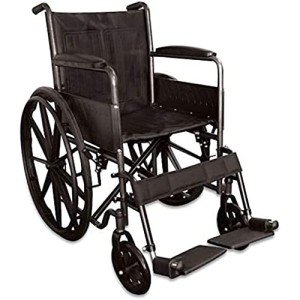Bariatric Wheelchair Seat Width
Seat Width
Having the correct seat width is essential to wheelchair users who spend longer periods in their chairs. Too narrow a seat will trigger pressure on the hips and thighs which might lead to sores or pressure points. Having too large a seat can likewise make it hard for the user to reach the hand rims to propel themselves or maneuver in small spaces.
To measure the correct seat width an individual would sit on a chair typically and have their measurement taken across their lap at the largest point which is generally their hips. A wheelchair measuring tape can be used to determine this, however a yard stick is preferred as it avoids people from wrapping the tape around their hips which would provide an unreliable result.
The basic wheelchair seat width is 16" (narrow grownup), 18" (standard adult), and 20" (large adult). For bariatric patients, a 24" seat is available. This durable extra broad bariatric wheelchair from Medline includes swing-away footrests, a carbon steel frame with rust- and chip-resistant chrome plating, and easy-to-clean vinyl upholstery. It has a weight capacity of 500 pounds.
Seat Depth

Typically, the seat depth of a bariatric wheelchair was added 2" to the measurement taken at the user's best point (normally their hips). This was implied to accommodate additional layers of clothes that may be used during cold weather condition. Nevertheless, this practice is ending up being less typical as wheelchair users have the ability to spend more time inside your home and are not wearing long coats. This makes the seat depth of a chair less essential when picking a bariatric wheelchair. Nevertheless, it is still essential to pick an option that provides appropriate assistance for larger users.
The Medline folding additional broad bariatric manual wheelchair features a comfortable 24" seat width and a durable slide tube silver vein frame. It likewise has an adjustable axle and tool-free elevating legrests.
Seat Height
When it comes to identifying the correct wheelchair seat width you must constantly measure from the user's widest point which is generally their hips. You will also need to consider whether the user is going to be using a winter coat as this might add 2" to the width needed.
When a wheelchair is in use it ought to just be operated on level surface areas with the wheel locks fully engaged. This is to avoid the chair from having the ability to move inclines that are 10 degrees or higher. It is also crucial to keep in mind that any activity that may shift the center of gravity in the chair must be made with care. This consists of grabbing products that need the person to lean out of their seat or attempting to stand from it.
Whenever bariatric wheelchair for sale near me have the chair in use it is suggested that you routinely inspect it for damage and lube any locations that are deemed needed. For instance, the casters should be lubed by getting rid of the caster fork and utilizing a multi-purpose grease to apply to the caster stem bearings. Also, the foot plates can be adjusted by loosening up the bolt and after that moving them to the preferred position. This allows the feet to sit easily on the footplate and avoids any pressure points from forming. This can be really uneasy for the user and if left unattended, can result in press sores.
Weight Capacity
Bariatric wheelchairs are developed to support more weight than standard wheelchairs. This makes them sturdier and much better geared up to handle falls. They are likewise generally bigger and wider, making them less maneuverable in tight areas than standard wheelchairs. They need automobiles with unique ramps and lifts to pack them, in addition to chauffeurs who know how to best transport them from one place to the next.
When choosing bariatric wheelchair for sale near me , consider its weight capacity as it will be the main determining aspect in whether it will accommodate your traveler's requirements. The weight capacity of the chair is frequently noted as a static load, meaning that it shows the amount of weight the chair can easily hold while standing still. Nevertheless, some manufacturers likewise note an active load that is based upon a drop test and can imitate the effect of somebody sitting down in the chair. This may be a more dependable measurement of the weight limit, depending upon your requirements.
If you plan to perform activities that shift your center of mass in the seat (such as grabbing things), make sure to have front casters pointed in a forward direction and wheel locks engaged so the chair will not tip over. Also, check that casters are lubed regularly to avoid excessive wear and abrasions. The lubrication treatment involves removing the fork, separating the caster from the wheel, and greasing the caster stem bearings with top quality multi-purpose grease.
